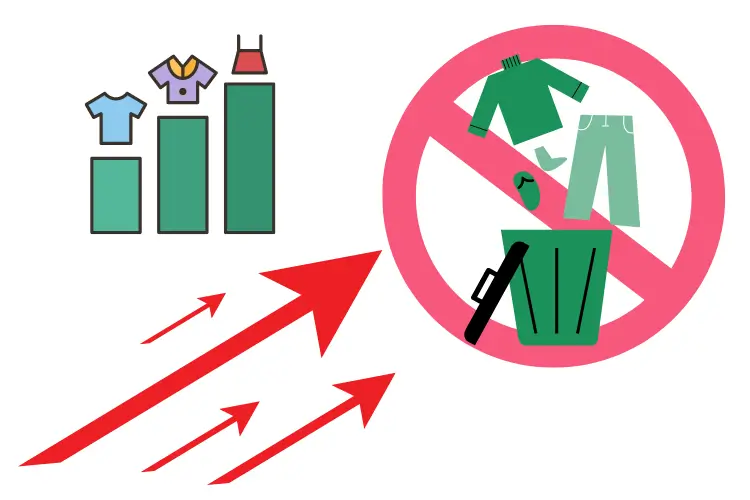The term fast fashion refers to clothing that moves quickly from design to retail stores to meet trends. These collections are often influenced by runway shows or celebrity looks. The aim of fast fashion is to offer a new look to mainstream consumers at an affordable price.

Short History of Fast Fashion
A fast fashion model emerged in the 1970s when retailers began exporting goods to Asian countries, where workers were paid lower wages than they were in Western countries. During the 1990s, companies increased production to keep up with trends, which led to its adoption. With fast fashion, consumers can now expect to see new clothing collections much more often, with some brands producing 36 collections a year, compared to four collections a year previously.
Fast Fashion Leaders
Major Players in the fast fashion market are listed below:
- Inditex
- H&M
- Gap
- Primark
- Best Seller
- Zara
- Mango
- Esprit
- C&A
- Cotton on group
- Future lifestyle fashions limited
- River island
- New look
- Arcadia
- Forever 21
Future trends of Fast Fashion
Day by day, fast fashion becoming popular. Here, I present some key points aspect on future trends of fast fashion.
- Supply chain transparency: The demand for greater transparency in the supply chain has grown as consumers become more aware of the ethical ramifications of the fashion industry. The fast fashion industry is responding by improving worker conditions, ensuring fair labor practices, and ensuring transparency.
- Digital transformation: Fast Fashion brands utilize digital platforms to engage with their target audiences, promote their products, and drive sales. E-commerce platforms and social media have transformed the way consumers interact with fashion. Influencers on social media also play an important role in shaping consumer preferences and trends.
- Personalization: Fast Fashion brands are offering personalized recommendations, customized products, and interactive shopping experiences with technology, such as artificial intelligence and data analytics.
- Sustainability: Consumers are increasingly seeking sustainable and eco-friendly fashion options as environmental issues become more apparent. By using recycled materials, implementing ethical sourcing practices, and minimizing waste in the production process, fast fashion brands are embracing sustainability.
Fast fashion Market Segmentation in future from today to 2030
Various factors, including product type, application, and region, can be used to segment the Fast Fashion market.
According to types:
- Skirt
- Coat
- Pants
- Others
According to the application:
- Women
- Men
- Children
According the region:
- South America: Colombia, Chile, Brazil, Peru.
- North America: Canada, Mexico, Cuba, United States.
- Middle East and Africa: UAE, South Africa, Iran, Syria.
- Europe: Germany, France, Russia, United Kingdom.
- Asia-Pacific: Indonesia, Japan, Australia, Japan, China
Advantages of fast fashion:
- Consumers have access to smart new clothes and fun or impractical items.
- As a result of fast fashion, buyers can obtain the garments they want when they want them, as well as make clothing more affordable – and not just any clothing, but clothing that’s innovative, imaginative, and stylish.
- Introducing new products frequently encourages customers to visit stores more often, which leads to more purchases. Retailers will not replenish their stock; instead, they will replace items that sell out with new ones.
- Fast fashion offers a wide range of styles and designs of garments. So It is easy to find suitable option or design for a consumer.
- Fast fashion can change design quickly according to the trends and consumer demands.
Disadvantages of Fast Fashion
- As a result of fast fashion, the U.S. garment industry has declined, despite strong labor laws and workplace regulations, as well as higher wages than in other countries.
- Fast fashion companies have been accused of illegally copying and mass-producing some designers’ designs.
- In contrast to traditional fashion, fast fashion makes use of cheap materials and manufacturing methods, causing pollution and waste, as well as planned obsolescence.
- The quality of garments is very low.
- Many fast fashionistas in their teens and early twenties-the age group the industry targets-admit they only wear their purchases once or twice.
Fast Fashion Impact on the Environment
Fast fashion consumers may find it difficult to avoid products manufactured by fast fashion companies, but they can investigate brands to see if they use sustainable processes and fair labor practices. Fast fashion impact on the environment in many ways. The Ellen MacArthur Foundation and the United Nations Environment Programme have compiled the following statistics:
- Annually, the industry uses 93 billion cubic meters of water.
- One pair of jeans needs to wash about 3,781 liters of water.
- There are few regulations for wastewater disposal in many countries where clothes are made, and 20% of all wastewater in the world comes from dyeing textiles.
- About 500,000 tons of microplastic fibers from clothing end up in the ocean – the equivalent of 50 billion plastic bottles.
- More than 10% of global carbon emissions come from the fashion industry.
Because of fast fashion, the environment will be polluted more and more every day. Because of competition among garment manufacturers to make more garments, the environment will be polluted more and more.
Kazi Md. Rashedul Islam
B.Sc-in-Textile Engineering (DUET)
Author & Founder: TextileTrainer.com
Email: [email protected]


